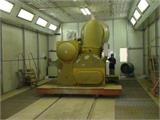Search Encyclopedia Paint Room
Summary of the Spray Booth Catalog 123456 Catalog 123456
Car spraying not only plays an aesthetic role, but also protects the body. Because cars often operate in damp and dusty harsh environments, painting can prevent metal parts from being eroded and delay the aging of plastic parts; at the same time, car manufacturers often achieve their design style through painting, making the car exterior more beautiful, bringing more. Once the body paint surface is damaged, a series of very professional facilities and technologies are required for repair, and the spray booth is an important piece of equipment in the process of repairing the body paint surface.
Principle of Operation of the Spray Booth: The spray booth is generally used for spraying and baking paint, so the most accurate description of the spray booth should be "spray-bake booth". It is widely used in the automotive, chemical and other industries for the surface painting and baking operations of workpieces.
During spraying, external air passes through the primary filter net and is then sent to the top of the room by a fan. After being purified by the secondary filtration on the top filter net, it enters the room. The air inside the room adopts a full-descending system, flowing downward at a speed of ≥0.3m/s, ensuring that the paint mist particles after spraying cannot remain suspended in the air, and are directly discharged out of the room through the bottom filter device. This continuous cycle conversion keeps the air cleanliness inside the spray booth above 98%, and the incoming air has a certain pressure, ensuring that dust outside does not seep into the spray booth, thus preventing contamination of the workpiece surface and ensuring the quality of the spraying to the maximum extent.
During baking, the wind door is adjusted to the paint baking position, with hot air circulation raising the temperature inside the paint booth quickly to the preset drying temperature (≤80℃). The fan initially filters the external fresh air, which then undergoes heat exchange with the heat converter before being sent to the air chamber at the top of the paint booth. After being purified again through the second filter, the hot air, due to the internal circulation effect of the wind door, mostly continues to be heated and reused except for the small amount of fresh air drawn in, gradually increasing the temperature inside the paint booth. When the temperature reaches the set temperature, the burner automatically stops; when the temperature drops to the set temperature, the fan and burner automatically turn on again, keeping the temperature inside the paint booth relatively constant. Finally, when the paint baking time reaches the set time, the paint booth automatically shuts down, ending the paint baking process.
The entire spray booth is a modular structure. The body uses mother-child plug-in thermal insulation spray-plastic wall panels, with good sealing and thermal insulation performance. The side of the body is equipped with a working door for easy entry and exit of staff; aluminum alloy edged doors, with observation windows in the center of the door, allowing real-time observation of the dynamics inside the room. Low-noise high-volume fans are selected to ensure the perfection of the spray effect; high-quality stainless steel heat exchangers, with high heat exchange efficiency and long service life.
Choosing a suitable spray booth not only meets the highest requirements for high-level spraying, allowing us to spray flawless car paint surfaces in the shortest possible time, but also provides painters with a safe, healthy, bright, and comfortable working environment. So, what makes a qualified spray booth?
In general, the quality of a spray booth should be measured from the following aspects:
1. Brightness.
Generally, the brightness inside the spray booth needs to reach 800-1000 lux, and lights close to D65 light source should be used, while the walls inside the room should be matte white;
2. Airflow.
The air inside the spray booth flows uniformly from top to bottom at a speed of 0.2-0.3 m/s;
3. Filtration Effect.
This depends on the type of cotton on the top of the spray booth. Generally, repair shops use EU5 and EU6 models. During use, you can shine a sun lamp upward inside the room, and usually, there should be less than five extremely fine dust particles per square meter;
4. Wall Sealing Effect.
The spray booth must be sealed, and there should be no accumulation of paint dust at the joints;
5. Positive Pressure Assurance.
The intake volume of the spray booth should be slightly greater than the exhaust volume, keeping the spray booth in a positive pressure state;
6. Sealing Effect of the Heating System.
Around the burner and chimney, good sealing should be ensured, with no oil ash appearing after combustion;
7. Temperature Rise Speed.
It takes about 10-15 minutes for the spray booth to rise from 20°C to 60°C. Also, note that some spray booths may have inaccurate thermometers, so the temperature measurement should be based on the metal body temperature inside the spray booth. If the spray booth you choose can meet the above conditions, it would be an ideal choice. However, during long-term use, many painters report issues such as poor quality of the spray booth, excessive dust inside, and unsatisfactory construction effects, sometimes even worse than outdoors. In fact, all these problems can be completely avoided if the spray booth is correctly used and maintained.
When using the spray booth, the following points should be noted:
1. Before spraying, check whether the spray air pressure is normal and ensure the filtration system is clean;
2. Check the air compressor and oil-water micro-dust separator to keep the spray hose clean;
3. Store spray guns, spray hoses, and paint mixing cans in clean places;
4. Except for dust removal using a blow gun and tack cloth, all other pre-spray processes should be completed outside the spray booth;
5. Only spraying and baking processes should be carried out inside the spray booth, and the spray booth door should only be opened when vehicles enter or leave. When opening the door, the air circulation system should be activated to generate positive pressure, ensuring that dust from outside cannot enter the room;
6. You must wear designated spray suits and safety protective equipment to enter the spray booth for operation;
7. During baking operations, flammable items inside the spray booth must be removed;
8. Unnecessary personnel are not allowed to enter the spray booth.
For daily maintenance, to maintain the optimal effect of the spray booth, the following cleaning and inspection tasks should be regularly performed:
1. Clean the walls, glass, and base seats inside the room every day to prevent dust and paint dust accumulation;
2. Clean the air intake dust-proof net once a week, check if the exhaust dust-proof net is clogged, and replace it if the indoor air pressure increases without cause;
3. Replace the floor dust-proof fiber cotton after every 150 hours of work;
4. Replace the air intake dust-proof net after every 300 hours of work;
5. Clean the floor water tray monthly and clean the diesel filter device on the burner;
6. Check every quarter if the drive belt of the intake and exhaust motors is loose;
7. Clean the entire spray booth and floor mesh every half year, check the circulating air valve, intake and exhaust fan bearings, check the exhaust channel of the burner, clean the sediment in the oil tank, clean the water-based protective film of the spray booth, and reapply it;
8. Clean the entire heat exchanger annually, including the combustion chamber and exhaust channel, and replace the top cotton of the spray booth annually or after every 1200 hours of work.
First, classified by airflow direction into three types.
Cross-flow spray booth:
Air flows from one end of the room to the other. This model is low-cost and easy to install. The disadvantage is that the mist moves along the side of the vehicle body, and the mist cannot be removed from around the operator's face, resulting in an unsatisfactory working environment.
Side down-draft spray booth:
Air enters the spray booth through the ceiling filter device and is discharged from the root of the side wall. This is a mid-priced spray booth. Since the mist is far from the vehicle body and can be removed from around the operator, both the spray effect and the working environment are relatively ideal.
Full down-draft spray booth:
It represents the most advanced technology today. Air enters from the ceiling and is discharged outside through the pit or basement. This exhaust method can obtain a cleaner spray process and a safer working environment. However, its cost is high, and it occupies a large space.
Second, classified by heating method:
It can be divided into diesel spray booths, electrically heated spray booths, steam-heated spray booths, far-infrared spray booths, waste engine oil spray booths, etc.
Third, classified by paint mist treatment method:
It can be divided into two major categories: dry-type spray booths and wet-type spray booths (water treatment).
The most commonly used spray booth is the dry-type treatment, so the filtration system (mainly referring to the primary filter cotton and secondary filter cotton) needs to be checked and replaced regularly, otherwise, it may affect the spray quality or even cause a fire.
With the further development of science and technology, the methods for handling excess paint mist are becoming increasingly advanced. Now, many high-end cars use water treatment spray booths, where the excess paint mist is processed and dissolved in water, achieving significant progress in the way of treating paint mist.
Structure of the Spray Booth:
The entire spray booth is a modular structure. The body uses mother-child plug-in thermal insulation spray-plastic wall panels, with good sealing and thermal insulation performance. The side of the body is equipped with a working door for easy entry and exit of staff; aluminum alloy edged doors, with observation windows in the center of the door, allowing real-time observation of the dynamics inside the room. Low-noise high-volume fans are selected to ensure the perfection of the spray effect; high-quality stainless steel heat exchangers, with high heat exchange efficiency and long service life.
Principle of Operation of the Spray Booth:
The spray booth is generally used for spraying and baking car paint, so the most accurate description of the spray booth should be "spray-bake booth".
During spraying, external air passes through the primary filter net and is then sent to the top of the room by a fan. After being purified by the secondary filtration on the top filter net, it enters the room. The air inside the room adopts a full-descending system, flowing downward at a speed of 0.2-0.3 m/s, ensuring that the paint mist particles after spraying cannot remain suspended in the air, and are directly discharged out of the room through the bottom outlet. This continuous cycle conversion keeps the air cleanliness inside the spray booth above 98% during spraying, and the incoming air has a certain pressure, forming a constant airflow around the car to remove excess paint, thereby maximizing the quality of the spraying.
During baking, adjust the wind door to the paint baking position, with hot air circulation rapidly raising the temperature inside the paint booth to the preset drying temperature (55℃-60℃). The fan initially filters the external fresh air, which then undergoes heat exchange with the heat converter before being sent to the air chamber at the top of the paint booth. After being purified again through the second filter, the hot air, due to the internal circulation effect of the wind door, mostly continues to be heated and reused except for the small amount of fresh air drawn in, gradually increasing the temperature inside the paint booth. When the temperature reaches the set temperature, the burner automatically stops; when the temperature drops to the set temperature, the fan and burner automatically turn on again, keeping the temperature inside the paint booth relatively constant. Finally, when the paint baking time reaches the set time, the paint booth automatically shuts down, ending the paint baking process. My evaluation: Entry Evaluation: 4 points (evaluated by 8 people).



